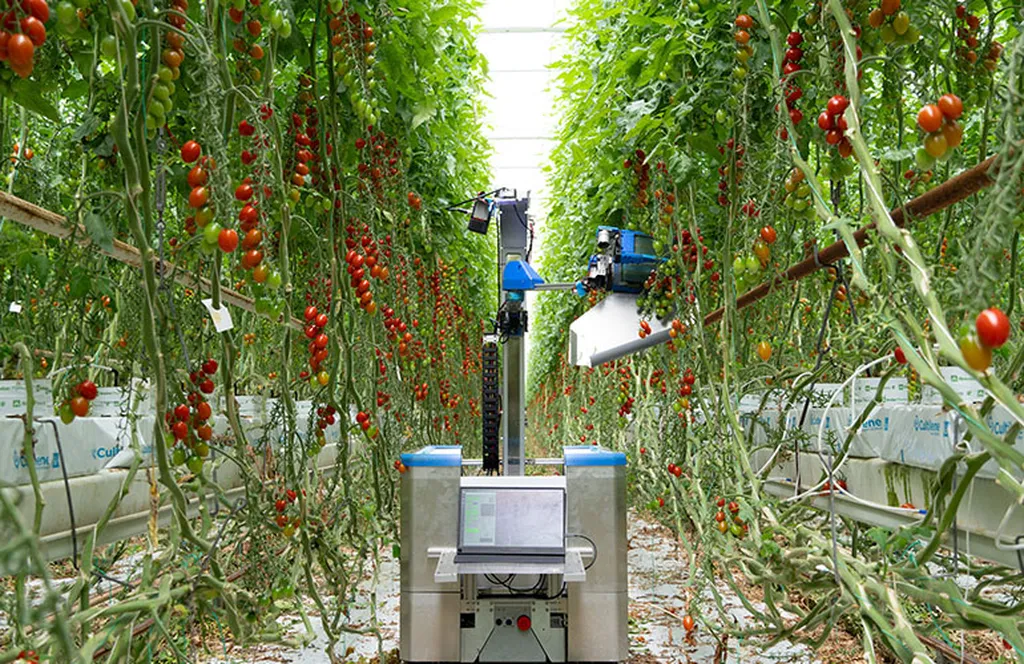In the heart of Honselersdijk, Netherlands, a significant stride in agricultural technology was recently unveiled at Tomatoworld. The Japanese company Inaho showcased its latest iteration of a snack tomato harvesting robot, marking a substantial leap towards commercial viability. This development is not just a win for Inaho but also a promising advancement for the global agritech industry, particularly in the realm of precision agriculture and automated harvesting.
The new design of Inaho’s harvesting robot is a testament to the company’s commitment to innovation and efficiency. The most notable improvement is the robot’s ability to approach, grasp, and cut snack tomatoes from an angle of around 60 degrees from the side. This enhancement significantly increases the success rate, as it allows the robot to reach and harvest fruits that were previously too difficult to access due to their position behind stems. This newfound dexterity is a game-changer, as it enables the robot to navigate the complex geometry of tomato plants with greater ease and precision.
Inaho has also equipped the robot with an additional camera, which plays a crucial role in optimizing the harvesting process. This camera, positioned on one side of the path, determines the position of the trusses on the opposite row of plants during harvesting. This feature speeds up detection and movement when the robot returns along the opposite row, thereby enhancing the overall efficiency of the harvesting process.
The collection mechanism of the robot has also undergone a significant upgrade. In the previous prototype, harvested fruits would fall and roll through a chute into the harvest crate at the bottom of the robot cart. However, this design has been replaced by a collection tray directly beneath the harvesting mechanism. After collecting several fruits, the robot arm moves towards the harvest crate. A flap opens, and the tomatoes roll from the temporary collection tray into the crates. This design not only ensures a gentler handling of the fruits but also allows for smarter decision-making. The robot’s software calculates whether it is more efficient to collect a few extra fruits first or to empty the tray before continuing, based on the proximity of the next truss and the time needed for detection and approach.
While the current version of the robot distributes the harvested snack tomatoes across three harvest crates placed side by side, Inaho has already designed a rotating stacking system for future versions. This system will allow the robot to carry more crates, further enhancing its efficiency and reducing the need for manual intervention. At present, an operator must still manually transfer the full crates onto a transport cart and move the robot to the next path. However, these tasks could potentially become autonomous functions in the future, paving the way for a fully automated harvesting process.
Inaho’s approach to harvesting robot development is unique in that it prioritizes affordability and ease of use over the highest possible percentage of successfully detected and harvested tomatoes. While other developers aim for around 80% success rates, Inaho’s robot is designed to pick the easiest-to-harvest tomatoes, with an expected success rate of around 45%. This strategy is not a compromise but rather a pragmatic approach that considers the practical realities of tomato farming.
The success of the harvesting process is heavily influenced by the variety of tomatoes being harvested. Inaho recognizes this and is actively seeking a partnership with a breeder who can develop a robot-friendly variety. At Tomatoworld, the switch from the variety Sweetelle to Dormaplum already demonstrated the positive impact that breeding can have on harvesting performance. The more compact and straighter trusses of Dormaplum make it easier for the robot to locate and harvest the fruits. Additionally, longer-lasting fruits that can stay on the truss a bit longer improve harvesting efficiency, as the truss can then be completely harvested in fewer visits. A slightly higher fruit weight, whether through genetic traits or truss pruning, also increases the number of kilograms harvested per hour. The use of the Qlipr system, instead of twisting the plants, further aids the robot by allowing more trusses to hang clearly in front of the stem and be more easily accessible.
The implications of Inaho’s advancements in harvesting robot technology are far-reaching. As the global population continues to grow, the demand for food production is expected to increase significantly. Automated harvesting technologies, such as Inaho’s robot, have the potential to play a crucial role in meeting this demand by increasing efficiency, reducing labor costs, and minimizing waste. Furthermore, these technologies can contribute to the sustainability of agriculture by promoting precision farming practices that optimize resource use and reduce environmental impact.
In conclusion, Inaho’s latest developments in snack tomato harvesting robot technology represent a significant step forward in the field of agritech. The company’s innovative design, strategic approach, and commitment to partnership and continuous improvement set a strong example for the industry. As the technology continues to evolve, it is likely that we will see even greater advancements in automated harvesting, ultimately contributing to

